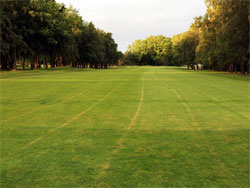|
What can "brown" do for us?
Jason Hooper, Quilchena Golf & Country Club, Quilchena, British Columbia:

Slit drains on #4 fairway
|
 "If you've played Quilchena over the past few weeks you'll notice that the soft and lush dark green turf conditions of the spring are now transforming into the firm and fast conditions that golfers crave. What I find funny though is that just as much as golfers love the extra 30 yards of roll on their drive and the more consistently fast green speed, many are still so reluctant to accept that 'brown is good'. Unless we were to use pigments to artificially colour our browning turf green, then you simply cannot expect to have fast and firm conditions on a daily basis without accepting brown turf. It truly is that simple.
I am often asked, 'Why do our drainage lines brown out so quickly when we experience dry weather conditions? Can't we hand-water them to keep them from doing so?' How long do you think it would take to hand-water the drainage lines on the fairway pictured (above right)?
"The good thing is that the brown drainage lines are excellent indicators of just how good our drainage system is..." |
Also, one would go absolutely crazy attempting to keep a drainage line that is filled with 100% sand moist enough to not turn brown. It's simply not possible in the summer months. The good thing is that the brown drainage lines are excellent indicators of just how good our drainage system is. It's these drainage lines that keep our fairways dry and firm all winter long. Heck, I can count on one hand how many times we had to keep carts on paths last winter because of soft fairway conditions. Not too shabby considering how much rain we had!
I guess the bottom line is to expect to see a whole lot more brown as the summer progresses and continue to expect fast and firm conditions that come along with it. For those of you who enjoy a softer and lush green golf course, don't worry... the rainy season will be here before you know it!
Here are a few other benefits of brown turf:
- less moisture = less susceptible to disease
"reduced irrigation saves $$$ — irrigation systems require lots of power to operate and water is not cheap..." |
- reduced irrigation saves $$$ - irrigation systems require lots of power to operate and water is not cheap
- less water use = being environmentally responsible
- reduced growth requires less mowing which allows us to focus on projects and 'detail work'
- less mowing requires less fuel, also a significant cost savings
- better turf quality and overall playability (again, enjoy that extra 30 yards of roll!)
There are certainly other benefits I haven't listed, but I think you probably get my point... BROWN IS GOOD!!!"
Visit Jason's blog at qgolfclub.blogspot.com.
|